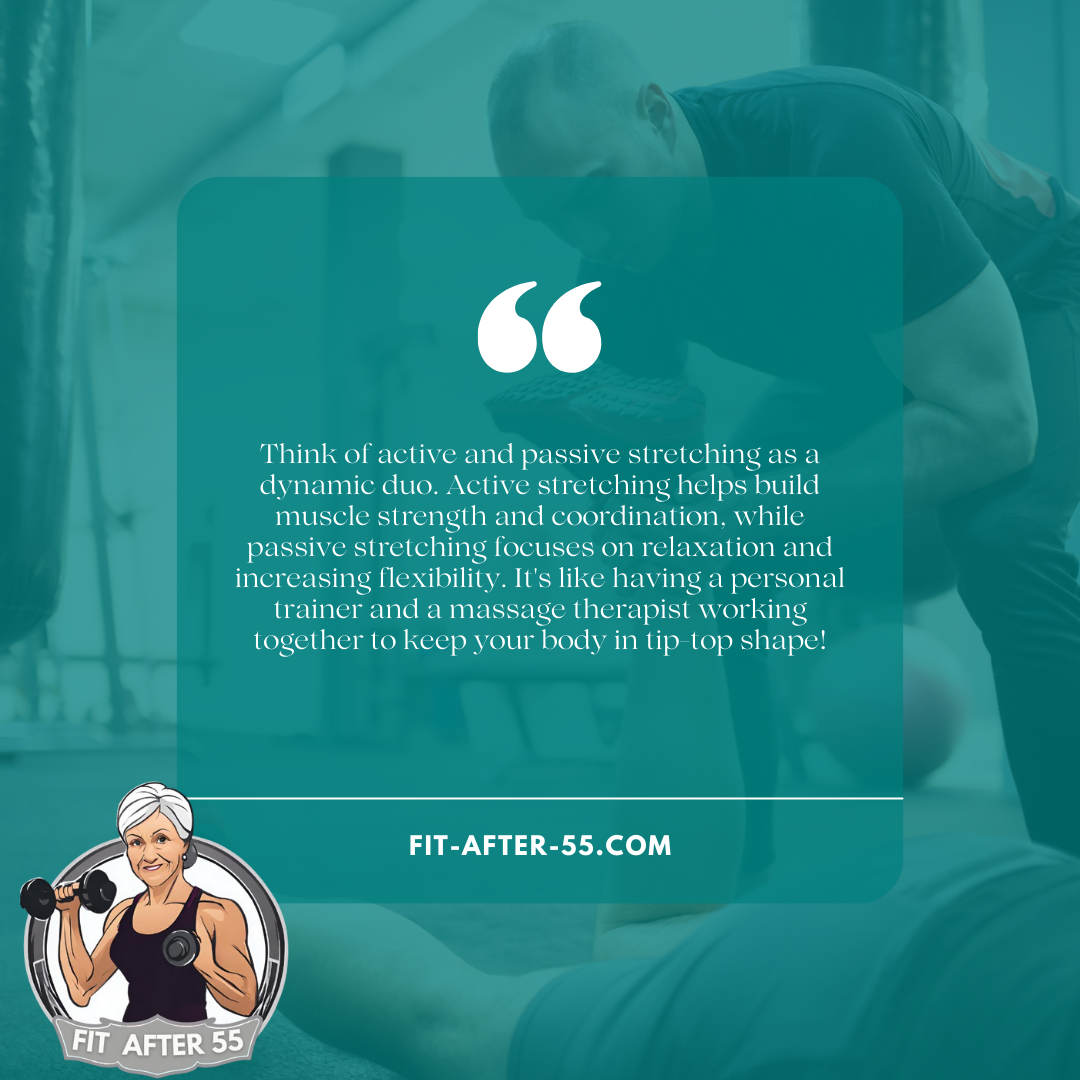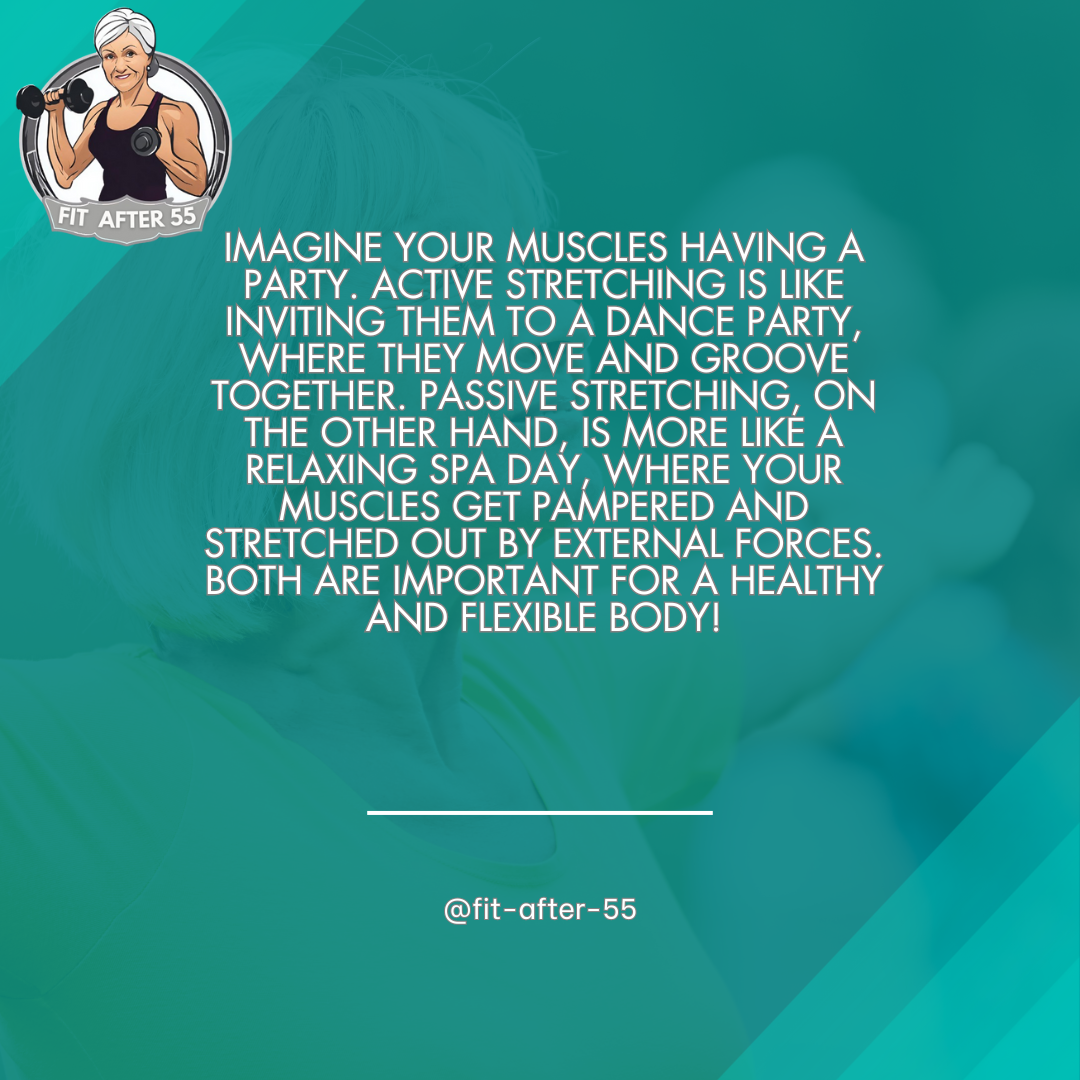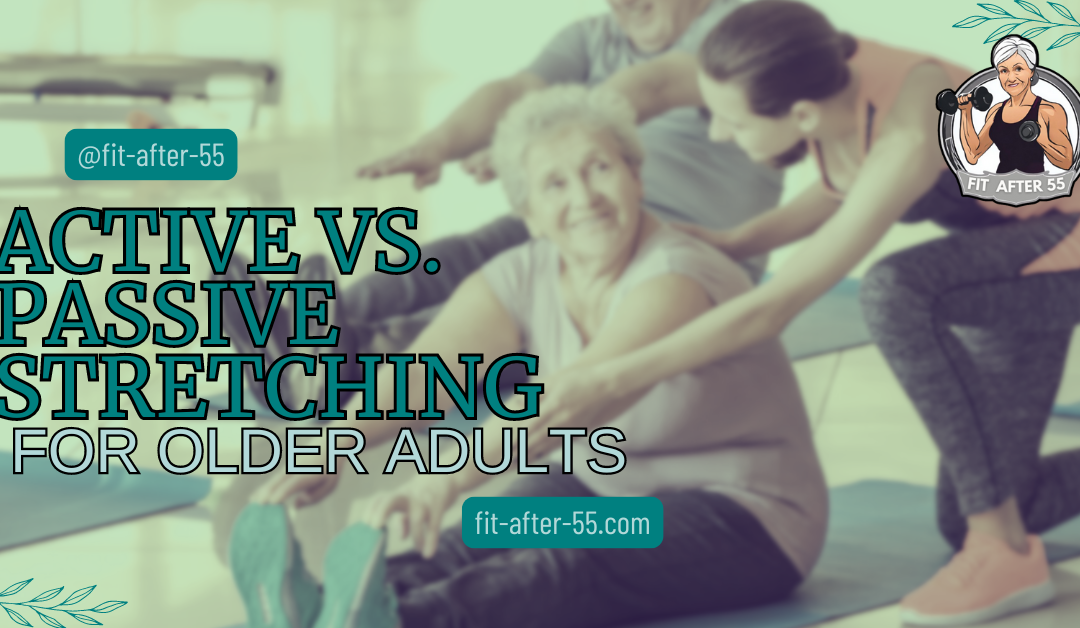Hey there! Are you curious about stretching but unsure whether to go for active or passive stretches? No worries—you’re not alone! When it comes to staying flexible and feeling great, especially as we get older, understanding the difference between active and passive stretching can make a big difference. Whether you’re looking to boost your muscle strength, improve your flexibility, or just feel more comfortable, knowing which type of stretch works best for you can help you get the most out of your routine. So, let’s break it down in a simple and friendly way to help you decide what might work best for you and keep you moving with ease.
Active Vs. Passive Stretching For Older Adults: Finding the Right Balance
I will kick things off by highlighting the significance of stretching for older adults. It’s not just about maintaining flexibility; it’s also about enhancing overall well-being and independence as we age. Stretching can improve posture, reduce discomfort, and even boost circulation, which is incredibly important in your golden years.
Now what exactly are active and passive stretching? You’ll find out about these two types of stretching and how each one plays a crucial role in keeping seniors healthy and mobile. I’ll draw from the latest research and guidelines recommended by health experts to give you a comprehensive understanding.

Furthermore, regular stretching can have multiple health benefits for seniors. It’s not only about preventing stiffness; it could also aid in managing conditions prevalent in older age, such as arthritis and diabetes, by promoting better blood flow and flexibility.
Choose something that resonates with you, because the best type of stretching is the one you’ll stick with. Our next section, ‘Defining Active Stretching: Engaging Muscles for Movement,’ will delve into how active stretching works and why it might be a good choice for your daily routine.
Key Takeaways
- Active stretching involves contracting your muscles to stretch them, while passive stretching involves using external force, like a partner or a prop, to stretch your muscles.
- Incorporate both types: Combining active and passive stretching can provide optimal results.
- Be patient: Improving flexibility takes time and consistent practice.


Defining Active Stretching: Engaging Muscles for Movement

Understanding Passive Stretching: The Gentle Approach
Passive stretching is all about inviting relaxation and ease into your routine. Unlike active stretching, where you use your own muscle strength to create a stretch, passive stretching relies on external help—be it a partner, a prop, or simply gravity—to gently push your muscles further into a stretch.
This type of stretching is particularly beneficial for older adults. It requires less muscular effort, making it easier to manage, especially if you’re recovering from an injury, dealing with arthritis, or experiencing limited mobility.
Here’s what makes passive stretching so valuable: It improves flexibility and range of motion gradually and comfortably. Many older adults find they can hold passive stretches for longer periods, allowing for a deeper, more effective stretch over time. This makes it easier to enhance flexibility without overexertion.
While active stretching focuses on engaging muscles to create movement, passive stretching is about finding stillness and letting your body relax into the stretch. It’s a gentle, almost meditative approach that not only benefits physical health but can also help relieve stress.
And here’s the best part: you don’t have to choose between active and passive stretching. Combining both types can provide a well-rounded approach to flexibility and overall wellness. Stay tuned as we dive into how to blend these two forms of stretching to create a balanced routine that fits your lifestyle and meets your physical needs.
Active vs. Passive Stretching for Older Adults: Benefits, Tips, and Best Practices
When it comes to maintaining flexibility and mobility as we age, stretching is a key component of a healthy routine. Understanding the differences between active and passive stretching can help you choose the best methods to enhance your flexibility and overall well-being. Here’s a breakdown of the benefits, tips, and best practices for both types of stretching.
Active Stretching

Benefits:
- Muscle Strength and Coordination: Active stretching uses your muscles to create a stretch, which helps strengthen those muscles and improve coordination. This is especially important for maintaining balance and preventing falls.
- Increased Flexibility: By actively engaging muscles, you can gradually increase your range of motion.
- Enhanced Muscular Endurance: Holding positions against gravity can build endurance and stamina.
Tips:
- Start Slowly: Begin with gentle stretches and gradually increase the intensity as your strength and flexibility improve.
- Use Controlled Movements: Perform stretches with deliberate, controlled motions to avoid strain.
- Incorporate Into Warm-Ups: Active stretching is great for warming up before more vigorous activities.
Best Practices:
- Examples: Try leg lifts, arm circles, and bridging. These exercises can be modified to fit your comfort level and ability.
- Consistency: Aim to include active stretches in your routine several times a week for best results.
- Listen to Your Body: Avoid pushing too hard—stretch within a comfortable range and focus on gradual progress.

Passive Stretching
Benefits:
- Relaxation and Ease: Passive stretching involves external forces, such as a partner or gravity, which can make the stretches more comfortable and less strenuous.
- Improved Flexibility: Helps increase flexibility and range of motion gently.
- Stress Relief: The relaxed nature of passive stretching can serve as a calming, meditative experience.
Tips:
- Supportive Tools: Use props like straps, pillows, or chairs to help you achieve and maintain stretches comfortably.
- Hold Positions Longer: Passive stretches are effective when held for longer periods, allowing deeper muscle relaxation.
- Incorporate Into Cool-Downs: Passive stretching is ideal for cooling down after exercise.
Best Practices:
- Examples: Consider stretches like using a strap for hamstring stretches or gentle partner-assisted stretches.
- Frequency: Incorporate passive stretching into your routine regularly, especially after workouts or during relaxation times.
- Avoid Overstretching: Stretch to a point of gentle tension, not pain, and maintain a focus on comfort and ease.
Combining Active and Passive Stretching
A well-rounded stretching routine often includes both active and passive stretches. By blending these approaches, you can benefit from the muscle-strengthening effects of active stretching and the relaxation and flexibility gains from passive stretching.
How to Blend Both:
- Warm-Up with Active Stretches: Start your routine with active stretches to engage your muscles and prepare them for movement.
- Cool Down with Passive Stretches: Follow up with passive stretches to relax and lengthen the muscles after the activity.
- Adjust to Your Needs: Depending on your fitness goals and physical condition, adjust the balance between active and passive stretching to suit your needs.
By incorporating both active and passive stretching into your routine, you can enhance your flexibility, maintain muscle strength, and improve overall comfort. Whether you prefer one type over the other or enjoy a combination, the key is to find a routine that works for you and keeps you moving with ease and enjoyment.
Stretching Safely: Best Practices and Precautions for Older Adults
You’re going to find out about the critical importance of safety when it comes to stretching, especially for older adults. This isn’t just about improving flexibility; it’s also about ensuring these exercises do no harm.
Don’t worry too much about pushing your limits. It’s vital to listen to your body and avoid any movements that cause pain or discomfort. If you feel a stretch, that’s good, but if it hurts, you’ve gone too far. Safety should always come first.
Consulting a healthcare provider before beginning any new exercise regimen, including stretching, is a wise move. This is especially critical if you have pre-existing conditions or concerns about your physical capabilities.
Incorporating the expertise of a physical therapist or trainer can be extremely beneficial. These professionals can provide personalized advice and adapt stretches to suit your current fitness level and any mobility restrictions you may have.
Lastly, take your time. You can always adjust your approach down the road. What’s important is establishing a habit of regular stretching that is both effective and enjoyable. Choose something that resonates with you, makes you feel good, and is within your ability to perform safely.

Fun Facts
Did you know that active and passive stretching each offer unique benefits that can enhance your fitness routine? Active stretching is like a mini workout—it actively engages your muscles, helping to improve strength, coordination, and stability. It’s a great way to warm up your body and prepare it for movement. On the other hand, passive stretching is more like a relaxation session. It relies on external forces, such as a partner, prop, or gravity, to gently lengthen your muscles, making it perfect for unwinding and increasing flexibility without exerting much effort.
The best part? Both types of stretching are beneficial in their own way. By combining active and passive stretches, you can achieve a balanced routine that boosts strength, flexibility, and overall well-being.
Comparing and Contrasting: Finding the Right Stretch for You

If you’re thinking about incorporating stretching into your daily routine, you’re definitely on the right track! But you might be wondering which type of stretching suits you best. Let’s break it down.
Active stretching involves using your own muscle power to stretch, without any external help. It’s a fantastic way to boost muscle endurance and strength. Think of it as a workout for flexibility and muscle tone—two benefits rolled into one. On the flip side, passive stretching is like having a helping hand. Whether it’s a partner, a prop, or gravity, the external assistance helps you hold the stretch. This method can be particularly beneficial if you have limited mobility or are recovering from an injury or surgery.
So, what’s the best choice? There’s no one-size-fits-all answer. If you’re relatively active and want to enhance muscle coordination and flexibility, active stretching might be your go-to. However, if you’re just starting out, have limited mobility, or prefer a gentler approach, passive stretching could be a better fit.
Why not try both? Experiment with different stretches to see what works best for your body. Often, a combination of active and passive stretching provides the most comprehensive benefits.
Always listen to your body and adjust as needed. If a stretch doesn’t feel right, don’t push it. Taking a gradual and mindful approach is key to avoiding injury and ensuring a positive experience. Ready to improve your flexibility and mobility? Share your stretching tips and routines with our community. Let’s inspire each other to stay active and healthy.

Frequently Asked Questions
To help you get started or refine your practice, here are some common questions about stretching for seniors, especially those with limited mobility:
What is the difference between active and passive stretching?
Active stretching involves using your own muscles to stretch and hold a position without external assistance. For example, lifting your leg and holding it in the air using your leg muscles is an active stretch. In contrast, passive stretching involves using an external force—such as a partner, a strap, or gravity—to help you hold a stretch. An example of passive stretching is using a strap to pull your leg into a stretch.
Which type of stretching is better for older adults?
Both active and passive stretching have their benefits for older adults. Active stretching can help improve muscle strength, coordination, and flexibility, while passive stretching is effective for enhancing overall flexibility and relaxation. The choice depends on individual goals, fitness levels, and physical limitations. A balanced routine incorporating both types can provide the best overall benefits.
Are there specific benefits of active stretching for seniors?
Yes, active stretching helps strengthen muscles and improve balance and coordination, which are essential for preventing falls and maintaining independence. It also increases blood flow and muscle control, making it ideal for warming up before physical activity.
What are the advantages of passive stretching for older adults?
Passive stretching is particularly beneficial for improving flexibility and relieving muscle tension without much effort. It is excellent for cooling down after exercise and can be very relaxing. It’s also suitable for those with limited mobility or conditions that make active stretching challenging.
Can older adults combine active and passive stretching in their routine?
Absolutely! Combining active and passive stretching allows older adults to benefit from both muscle activation and relaxation. For example, starting a routine with active stretches can warm up the muscles and prepare them for movement, while finishing with passive stretches can help cool down and promote relaxation.

Stay Active and Feel Your Best!
Are you looking for fitness inspiration and ways to stay healthy as you age? Visit our Facebook page, which is filled with practical tips, creative tricks, and workout routines specifically designed for those 55 and older. Join our vibrant community to explore enjoyable ways to stay active, boost your energy, and enhance your overall well-being.
Connect with like-minded individuals, share your journey, and get motivated to live a healthier, happier life. Let’s keep moving and thriving together!

